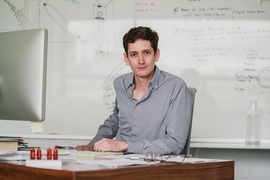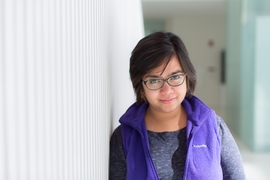Will the recent U.S. withdrawal from a 2015 accord that put restrictions on Iran’s nuclear program make it easier for Iran to pursue the bomb in secret? Not likely, according to Scott Kemp, an associate professor of nuclear science and engineering at MIT.
“The most powerful insights into Iran’s nuclear program come from traditional intelligence, not from inspections by the International Atomic Energy Agency,” says Kemp, who this week published a commentary article in Nature on the interplay of policy and science in North Korea.
But covert nuclear-weapon programs, whether in Iran, North Korea, or elsewhere in the world, are a major unsolved problem, according to Kemp. He recently explained the technical challenges involved in the hunt for clandestine sites. And he floated a possible solution.
What inspectors look for
Inspectors want to search for the secret production of plutonium or highly enriched uranium, says Kemp. Manufacturing an actual explosive device can be accomplished quickly and discreetly once either of these ingredients is secured in enough quantity. “The assembly work can be done in an office building, underground facility, or even in a big kitchen. It’s nearly impossible to detect once the program reaches this point.”
The good news, relatively speaking, is that manufacturing these explosive materials can leave telltale clues.
“All international efforts to prevent nuclear proliferation focus on preventing the production of plutonium and highly enriched uranium,” says Kemp. “The hope is to stop the material from ever being produced in the first place, or at least in sufficient quantities to make a nuclear bomb.”
What are the telltale clues of covert production?
“The production of either plutonium or highly enriched uranium is a major operation that requires people and time,” says Kemp. The involvement of many people means traditional intelligence has some chance of finding the program. But traditional intelligence can be unreliable, especially in closed societies like North Korea. Technical mechanisms would provide a useful overlay.
Detecting plutonium production, Kemp says, is easier than detecting enriched-uranium production for several reasons. The first clue is the heat signature. “Nearly all plutonium production occurs in nuclear reactors, and they obviously produce a lot of heat,” he says. “There are clever things a country could do to hide the heat signature, but they are not simple. Infrared satellites can search for waste heat leaving buildings, or being pumped into rivers or oceans.
A second clue comes from chemical signatures. The processing of reactor fuel to extract plutonium creates chemical effluent, which could be another promising detection pathway. “In addition to plutonium, the nuclear reactor will also produce a mix of other radionuclides — and while most are trapped in the reactor, a few leak out to the environment,” says Kemp, “especially the noble gases, such as radioactive isotopes of xenon and krypton.”
Scientists may be able to detect these isotopes — xenon-131, xenon-135, and krypton-85 —when they seep into the environment. “Governments already use detectors to look for those small signatures of the operation,” he says. “But a country could do all sorts of fancy things, like cryogenically freezing the off-gas, to eliminate the chemical signature if they wanted to. So we may or may not find signs of plutonium production this way.”
And what about uranium enrichment? “It also produces a distinct chemical signature,” says Kemp, which is caused when uranium hexafluoride (UF6) gas leaks into the atmosphere. The probability of a leak is very small, but it happens. When the gas escapes into open air, water vapor causes it to decompose into hydrofluoric acid and a specific kind of dust-like aerosol. The hydrofluoric acid is not useful in terms of detection. It is too reactive and disappears whenever it touches dirt, or a building, or a tree. “You are not going to detect it at any meaningful distance,” says Kemp. But the other byproduct, the dust-like aerosol, is another story.
A new way to track secret nuclear activity
The dust produced by uranium enrichment is an aerosol called uranyl fluoride (UO2F2), and it has a chemical form that is unique to uranium processing operations, says. Kemp. He is interested in working with his colleagues on the engineering faculty to develop detectors that can identify the molecule's distinctive chemical bonds. “There are many techniques for identifying molecules, but the sensitivity required in this case is exceedingly high, and the aerosol form presents a number of other challenges,” he says.
“If we could come up with extremely sensitive detectors that are cheap enough to put around a country without a lot of fancy equipment or maintenance, we would make significant inroads into the problem of detecting clandestine uranium-enrichment programs.” Imagine, he says, something like small weather stations with a solar-powered box that has a tamper-proof seal on it. It has a tiny fan that blows air over a sensor that searches the telltale U-F bond, and then sends an alert signal if the molecule is detected.
“After a localized detection, you could use weather data to project backward and estimate the most probable places this molecule came from. If you could eventually narrow it down to a few buildings or a couple city blocks, then it would be feasible for international inspectors to request access under existing legal provisions to see what is inside.”
A return to the politics
The ongoing presence of the International Atomic Energy Agency, which monitors Tehran’s most sensitive factories and research labs, is provided for by the long-established Treaty on the Non-Proliferation of Nuclear Weapons, or NPT, which Iran is unlikely to withdraw from, says Kemp. That means inspection teams can continue to check known nuclear facilities as before.
However, a special provision, called the Additional Protocol, has allowed the IAEA to have wide-ranging access over the past three years, including the right to venture out to investigate tips about suspicious sites. This provision also permits the IAEA to deploy environmental sensors of the kind Kemp wants to build. It is these extra privileges that would be at risk if Iran withdraws from the 2015 accord, says Kemp. The IAEA has used these privileges to make at least 60 visits to facilities that are not part of Iran’s declared nuclear program.
“But politics ultimately drives this in the end,” he adds. “If inspectors learned something, whether from intelligence or sensors, but were refused the additional access needed to follow up on the lead, then the international community would probably presume the worst. It would therefore still be in Iran’s interest to provide follow-up access even if they did not technically have to — that is, unless they were really hiding something.”










